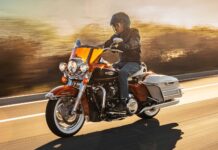As long as you can reach the pedals and the grips you can pretty much operate any motorcycle somewhat competently, and in the case of Harley-Davidsons it’s no secret that considerations of styling and curb appeal are often the more decisive factor in selecting a model than considerations of optimal control, function and comfort. Your capacity for enduring less than ideal saddle conditions is generally directly proportional to your propensity for putting some long miles on the machine from time to time, but endure it we do nonetheless. We’re adaptable critters, we are, and can with deceptive ease make peace with our lot, reconciling ourselves to the odd cramp, crimp, kink, Charlie horse or monkey butt, and the errant draft off a windscreen that tends to stream mad bees straight into our buckets.
No big deal, right? We are, after all, bikers. We’re philosophical about such torments. We’re willing to suck it up. We’re tough. We’re stoic. We’re resilient. We’re… we’re… we’re actually always ready to consider other options.
But making significant or even subtle changes to the basic positioning of operator and passenger and optimizing wind properties and cockpit protection has long been very much a shot in the dark; one that required making an educated guess about what arrangements of available seating and windscreen options might prove the ergonomic grail and improve matters appreciably, and taking that leap of faith could prove costly and all too often unsatisfactory.
Happily, and perhaps belatedly, Harley-Davidson is addressing that quandary with the rollout of an ambitious new program to be offered starting this month entitled the Seat and Windshield Demo Program. The way it works is that you bring your personal scoot over to the dealership and try out some optional components, having them installed on your bike and then taking it out for some real-world road testing, giving you some meaningful seat time from which to draw your conclusions about the products’ potential advantages over your current setup.
It’s a two-part program, the more extensive portion dedicated to seating and involving a whole slew of perching options applicable to a wide variety of models on every H-D platform—XL, Dyna, Softail, Touring, Trike and VRSC.
Included in the collection of demo seats are models such as the Reach, Reduced Reach and Super Reach—seats that depending on your choice and bike model can move your fanny forward as much as three inches or as little as one; the Tallboy, which will scoot your tush back as much as two inches or raise it as much a three; the Signature Series which gives you a wide seating area with a narrow nose as well as an operator backrest; the deep-pocketed Sundowner; and a pair of Tourer-specific jobs, the inner-suspended Hammock and air-adjustable Road Zeppelin. The range of possibilities presented should suit nicely practically any height, inseam or posture, as well as apportion saddle space more commodiously between rider and pillion pal—something that can go a long way towards keeping happy couples happy after eight or 10 hours on the highway. A difference of an inch or two forward or backward, up or down, or side to side, can make a whole world of difference in your enjoyment of your ride.
Complementing the seat sampling portion of the new program is the windscreen option. That idea is not entirely original, having been borrowed in large measure from Klock Werks who last year instituted a like dealer program termed “Try it Before You Buy it” that set out to demonstrate the touted advantages of that company’s unique Flare windscreens—unorthodox wind tunnel-test sculpted windscreens that redirect airflow properties. Somewhat similar products are offered by National Cycle and Cee Bailey, and, of course, The Motor Company. Some users of the devices absolutely swear by one or another of them—others, not so much. Few things are more model specific or operator subjective than that assessment, but in any event they’ve proven a huge seller. Harley-Davidson’s own Wind Splitter design is now the subject of the similarly conceived demo program, and it is applicable only to full-fairing Touring models, sporting either batwings or shark nose prows. There are three heights of Wind Splitter, and both dark and light smoke tints are offered for testing. The value of the program is two-fold, 1) to see if the Wind Splitter’s all you hope it is, and 2) what’s the best height for your own purposes? And there’s no risk involved. If you don’t like it, don’t buy it.
Overall the Seat and Windshield Demo Program is an outstanding addition to H-D’s customer service offerings, for sure, but what would make it even better and of more widespread value would be to extend the windscreen portion beyond its exclusively Wind Splitter focus and adapt it to the many sizes and styles of traditional flat replacement shields for the quick-release units—starting, with the Road King to finish off the Touring models, and then moving on to the Heritage and Switchback. And so on. Then and only then could you do a truly thorough mixing and matching of the components being demonstrated on most models.
As part of the current program, just to keep everybody honest, all of the demo parts will bear the word emblazoned “Demo” all over them to discourage a quick switcheroo by unscrupulous types leaving behind a roach seat and fleeing with a brand new replacement unit. That should do the trick—for the most part, anyway. For there’s always the exception, and just between you and me, I’ve been spending the winter building a “Demo” themed bike, with “Demo” graphics plastered stem to stern, even on the tires. All I’ve been lacking are the seat and windshield. Talk about lucky timing.
It’s all right here in the diaries.
(Currently, about 80 percent of Harley-Davidson dealerships have signed on for the demo program. Check with your own to see if they’re participating or planning to.) 4




















